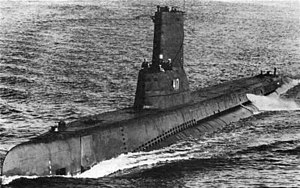| Tench-class submarine | |
|---|---|
 | |
| Class overview | |
| Builders: | Portsmouth Naval Shipyard, Electric Boat Company, Boston Navy Yard[1] |
| Operators: |
|
| Preceded by: | Balao class |
| Succeeded by: | Barracuda class |
| Subclasses: | Corsair class |
| Built: | 1944–1951[2] |
| In commission: | 1944–1975[2] |
| Completed: | 29[1] |
| Cancelled: | 51[1] |
| Active: | 1[1] |
| Lost: | 0[1] |
| Retired: | 28[1] |
| Preserved: | 3 |
| General characteristics | |
| Type: | Diesel-electric submarine |
| Displacement: |
1,570 long ton (1,595 tonne) surfaced[1] 2,416–2,429 tons (2,455–2468 t) submerged[1] |
| Length: | 311 ft 8 in – 311 ft 9 in (95.0 m)[1] |
| Beam: | 27 ft 3 in – 27 ft 4 in (8.3 m)[1] |
| Draft: | 17 ft (5.2 m) maximum[1] |
| Propulsion: |
4 × diesel engines driving electrical generators (Fairbanks-Morse or General Motors)[1] |
| Speed: |
20.25 knots (38 km/h) surfaced[3] 8.75 knots (16 km/h) submerged[3] |
| Range: | 11,000 nautical miles (20,000 km) surfaced at 10 knots (19 km/h)[3] |
| Endurance: |
48 hours at 2 knots (3.7 km/h) submerged[3] 75 days on patrol |
| Test depth: | 400 ft (120 m)[3] |
| Complement: | 10 officers, 71 enlisted[3] |
| Armament: |
|
Tench-class submarines were a type of submarine built for the United States Navy (USN) between 1944 and 1951. They were an evolutionary improvement over the Gato and Balao classes, only about 35 to 40 tons larger, but more strongly built and with a slightly improved internal layout. Further improvements were made beginning with SS-435, which are sometimes referred to as Corsair class.
Initial plans called for 146 to be built, but 115 were cancelled in 1944 and 1945 when it became apparent that they would not be needed to defeat Japan. The remaining 31 were commissioned between October 1944 (Tench) and February 1951 (Grenadier).
One Tench (ex-Cutlass) was transferred from the USN to the Republic of China Navy as Hai Shih. Two went to Italy as the Gianfranco Gazzana-Priaroggia class. USS Argonaut (SS-475) was sold to the Royal Canadian Navy in 1968, renamed HMCS Rainbow, and decommissioned in 1974.
Some of the class were updated through the GUPPY (The Greater Underwater Propulsion Power Program). The difference is noticeable by the level foredeck and the rounded bow.[6]

Sailor in his bunk aboard a typical wartime fleet boat.
Museums[]
Three Tench Class submarines are on display for the general public.
- USS Requin (SS-481) at the Carnegie Science Center in Pittsburgh, PA.
- USS Torsk (SS-423), moored at Pier Three, Baltimore's Inner Harbor, (alongside the National Aquarium in Baltimore) in Maryland.
- USS Thornback (SS-418), on display at Rahmi M. Koç Museum, Golden Horn in Istanbul.
See also[]
| Wikimedia Commons has media related to Tench class submarines. |
References[]
- ↑ 1.00 1.01 1.02 1.03 1.04 1.05 1.06 1.07 1.08 1.09 1.10 1.11 1.12 1.13 1.14 1.15 Bauer, K. Jack; Roberts, Stephen S. (1991). Register of Ships of the U.S. Navy, 1775-1990: Major Combatants. Westport, Connecticut: Greenwood Press. pp. 280–282. ISBN 0-313-26202-0.
- ↑ 2.0 2.1 Friedman, Norman (1995). U.S. Submarines Through 1945: An Illustrated Design History. Annapolis, Maryland: United States Naval Institute. pp. 285–304. ISBN 1-55750-263-3.
- ↑ 3.0 3.1 3.2 3.3 3.4 3.5 3.6 U.S. Submarines Through 1945 pp. 305-311
- ↑ 4.0 4.1 U.S. Submarines Through 1945 pp. 305–311
- ↑ Lenton, H. T. American Submarines (Doubleday, 1973), p.101.
- ↑ http://www.globalsecurity.org/military/systems/ship/guppy.htm
| ||||||||||||||||||||||||||||||||||||||||||
| |||||||||||||||||||||||||||||||||||||||||
The original article can be found at Tench-class submarine and the edit history here.